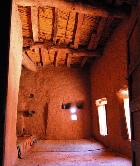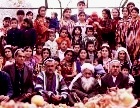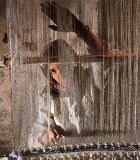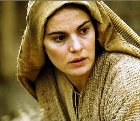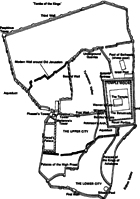The people of Nazareth
Questions for Bible study groups
- What did the people of ancient Nazareth (like Jesus, Mary and Joseph) look like?
- What work did Nazareth people in general do?
- What work did the women of Nazareth do?
- What did the people of Nazareth (like Jesus) do for entertainment?
People: what did they look like?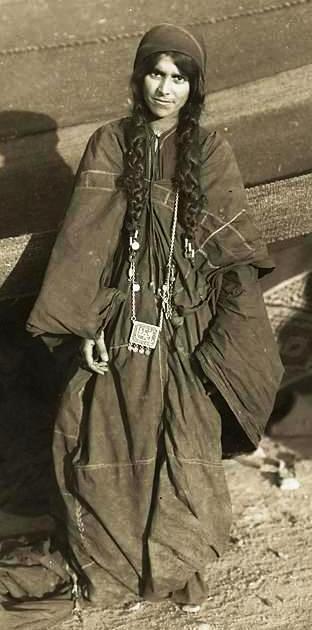
First of all, what did the people of ancient Nazareth (like Mary and Joseph) look like?
They would have been shorter than modern people, about five feet tall for women and a bit more for men. They were robust, sturdy, with strong brown hands callused from work, and glossy black hair.
Peasant women often painted a line of red or purple dye down the center parting of their hair, and wore modest pieces of jewelry. Their clothes were homespun wool or linen, loose fitting, in one of the soft colors of natural dyes – cream, a deep faded pink, or a soft grey. Both sexes wore leather ankle-length boots in winter, sandals in summer, and cut their dusty toenails with a sharp knife.
For images and more information, go to Clothes for Rich and Poor
The 19th century photograph of a Bedouin girl at right gives some idea of the clothing and decoration of a Middle Eastern woman from a nomadic tribe. Of course, Mary lived in a village surrounded by good farm land, and would have been slightly more affluent than women of nomadic tribes. But there were similarities. The girl in the photograph wears a garment that is not only handwoven but homespun as well. Women in the biblical period made their family’s garments from scratch.
What work did Nazareth people do?
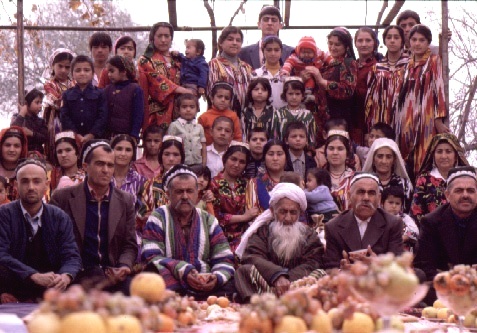 Joseph was a builder – not a carpenter, since there was little need for a carpenter in a small village, and wood was a luxury item. He probably had to travel to get jobs outside Nazareth, but there was plenty of work at the time, since Herod Antipas had recently redesigned and rebuilt the nearby town of Sepphoris.
Joseph was a builder – not a carpenter, since there was little need for a carpenter in a small village, and wood was a luxury item. He probably had to travel to get jobs outside Nazareth, but there was plenty of work at the time, since Herod Antipas had recently redesigned and rebuilt the nearby town of Sepphoris.
Mary was a junior member of a large Jewish peasant family, always surrounded by other people. She did the traditional work of women – preparing food, washing, fetching water from the well, working in the fields owned by her family, helping other women raise their many children.
If you were a young Jewish woman like Mary of Nazareth you lived with your extended family, or with the family of your husband. Your home was made of stone and mud-brick and though it might not have been beautiful on the outside, inside it was cool, comfortable and pleasant. For images and information, see Women’s Work or Bible Archaeology: Work
As far as we know, Jesus’ family lived a normal life in Nazareth. They were devout, traditional Jews, travelling often to Jerusalem for the major religious festivals. Their son Jesus was taught building skills by his father Joseph, and was expected to carry on the family trade. Their lives were simple, ordinary, humdrum.
Shepherds and their sheep
Shepherds and flocks were a common feature of everyday life in biblical times. A flock depended utterly on its shepherd for safety, food and daily care, so the shepherd became a common symbol of God’s care for humanity and all creation.
The two most famous uses of this symbol are in Psalm 23 and in John 10. Both of these passages link the good Shepherd with divine care:
“The Lord is my Shepherd, I shall not want.
He makes me lie down in green pastures; he leads me beside still waters; he restores my soul.
He leads me in right paths for his name’s sake.
Even though I walk through the darkest valley, I fear no evil; for you are with me;
your rod and your staff – they comfort me.” Psalms 23:1-4
“I am the good shepherd. The good shepherd lays down his life for the sheep.
The hired hand, who is not the shepherd and does not own the sheep, sees the wolf coming and leaves the sheep and runs away – and the wolf snatches them and scatters them.
The hired hand runs away because a hired hand does not care for the sheep.
I am the good shepherd. I know my own and my own know me,
just as the Father knows me and I know the Father.
And I lay down my life for the sheep.” John 10:11-15
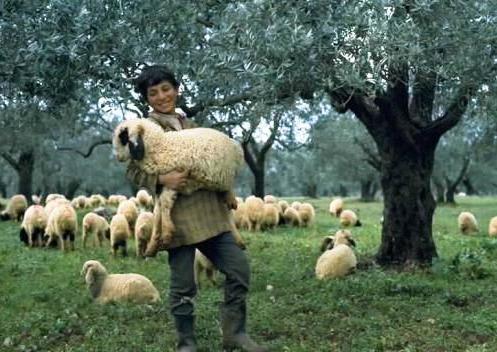
Women’s work
A woman in 1st century Nazareth performed all the small tasks expected of any woman in a farming community:
- she washed clothes in an open-air communal water-trough; these wash-troughs all over the Mediterranean world were scenes of camaraderie and gossip
- she carted water from the ancient spring that served everyone in Nazareth
- she cooked food – steaming bread cakes were a daily item. A primitive sort of popcorn, made by putting fresh grain on a hot metal plate, was popular
 she preserved food; at certain times of the year the women were swamped with the task of drying grapes, dates and figs. Olives were eaten fresh or pickled. There was a wide range of vegetables, eaten fresh or dried: beans, lentils and peas, onions and leeks, melons and cucumbers. These were made into spicy soups. Goat cheese and yogurt were eaten fresh because of the heat. Dried fish and eggs were sources of protein, with chicken, mutton and lamb for special occasions. The food may have been simple, but the taste was strong, seasoned with rock salt, vinegar, mint, dill and cumin
she preserved food; at certain times of the year the women were swamped with the task of drying grapes, dates and figs. Olives were eaten fresh or pickled. There was a wide range of vegetables, eaten fresh or dried: beans, lentils and peas, onions and leeks, melons and cucumbers. These were made into spicy soups. Goat cheese and yogurt were eaten fresh because of the heat. Dried fish and eggs were sources of protein, with chicken, mutton and lamb for special occasions. The food may have been simple, but the taste was strong, seasoned with rock salt, vinegar, mint, dill and cumin- she made clothes; the clothes of the day were simple, but they are made from scratch by the women of each family
- she tended the goats and sheep who grew the wool, clipped the animals, carded and spun the wool, wove the cloth, shaped and sewed the clothes, mended them when they showed signs of wear….. Each house was a thriving little production center
- every Jewish woman, young and old, knew the small tasks involved in caring for the elderly, and for family members who were ill – sponging their face and hands, combing their hair, keeping the room where they lay as quiet as possible.
The work may have been shared among all the women, but it was still heavy work, and Mary of Nazareth probably ate her food with a hearty appetite at the end of the day.
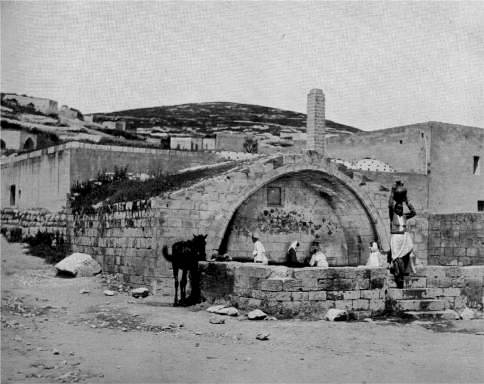
The spring of the Virgin in Nazareth, 19th century photograph
Farming
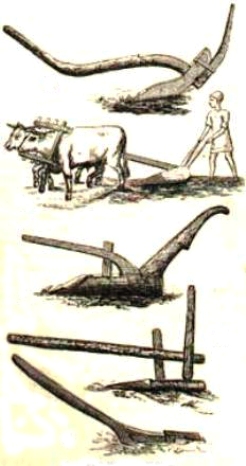 Almost everyone in Nazareth, men and women, were farmers. They had to be, since very little was imported from outside the village. It was heavy, continuous work, and Jesus was certainly familiar with it. He probably even worked in the fields as a boy, judging from Luke 8:5-8, the Parable of the Sower:Ancient ploughs and oxen
Almost everyone in Nazareth, men and women, were farmers. They had to be, since very little was imported from outside the village. It was heavy, continuous work, and Jesus was certainly familiar with it. He probably even worked in the fields as a boy, judging from Luke 8:5-8, the Parable of the Sower:Ancient ploughs and oxen
5 “A farmer went out to sow his seed. As he was scattering the seed, some fell along the path; it was trampled on, and the birds of the air ate it up. 6 Some fell on rock, and when it came up, the plants withered because they had no moisture. 7 Other seed fell among thorns, which grew up with it and choked the plants. 8 Still other seed fell on good soil. It came up and yielded a crop, a hundred times more than was sown.” When he said this, he called out, “He who has ears to hear, let him hear.”
Ploughing was done in the wet season, from October to April. This was also the time for sowing seed, harrowing and weeding. Flax and barley were harvested in April and May, then wheat.
Vines had to be pruned and tended during the growing season, then the grapes picked from July to October. Grapes were used as dried fruits, and for making wine. Most people also grew fig and olive trees in their plots of land.
There is a full description of ancient farming, with photographs and archaeological drawings, at Bible Archaeology: Agriculture.
Entertainment in Nazareth
Women in rural communities like Nazareth did not read, since it was unnecessary. Instead, stories were memorised.
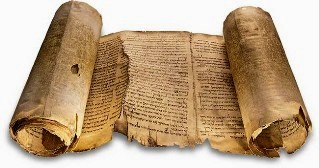
Mary of Nazareth was part of an oral society that gloried in story-telling. The great enemy in ancient societies was boredom, and clever talk kept boredom at bay. People in the ancient world told stories and acted them out for pure enjoyment. There is, after all, more sex and violence in Scripture than in anything that has come out of Hollywood. Read Judges 19 (a husband indifferent to the gang rape of his wife) or Genesis 38 (seduction and deceit). It was not only the handing-on of traditional stories, but a challenge to the audience to make judgements about what was right and wrong.Scrolls of the Torah
Mary almost certainly knew the five books of Torah by heart. It was a woman’s responsibility to teach her children about Yahweh and Judaism until the age of seven. Boys were then handed over to a male teacher at the synagogue, and taught to read. A former queen of Israel, Alexandra, had mandated that all Jewish boys should be able to read the Scriptures.



